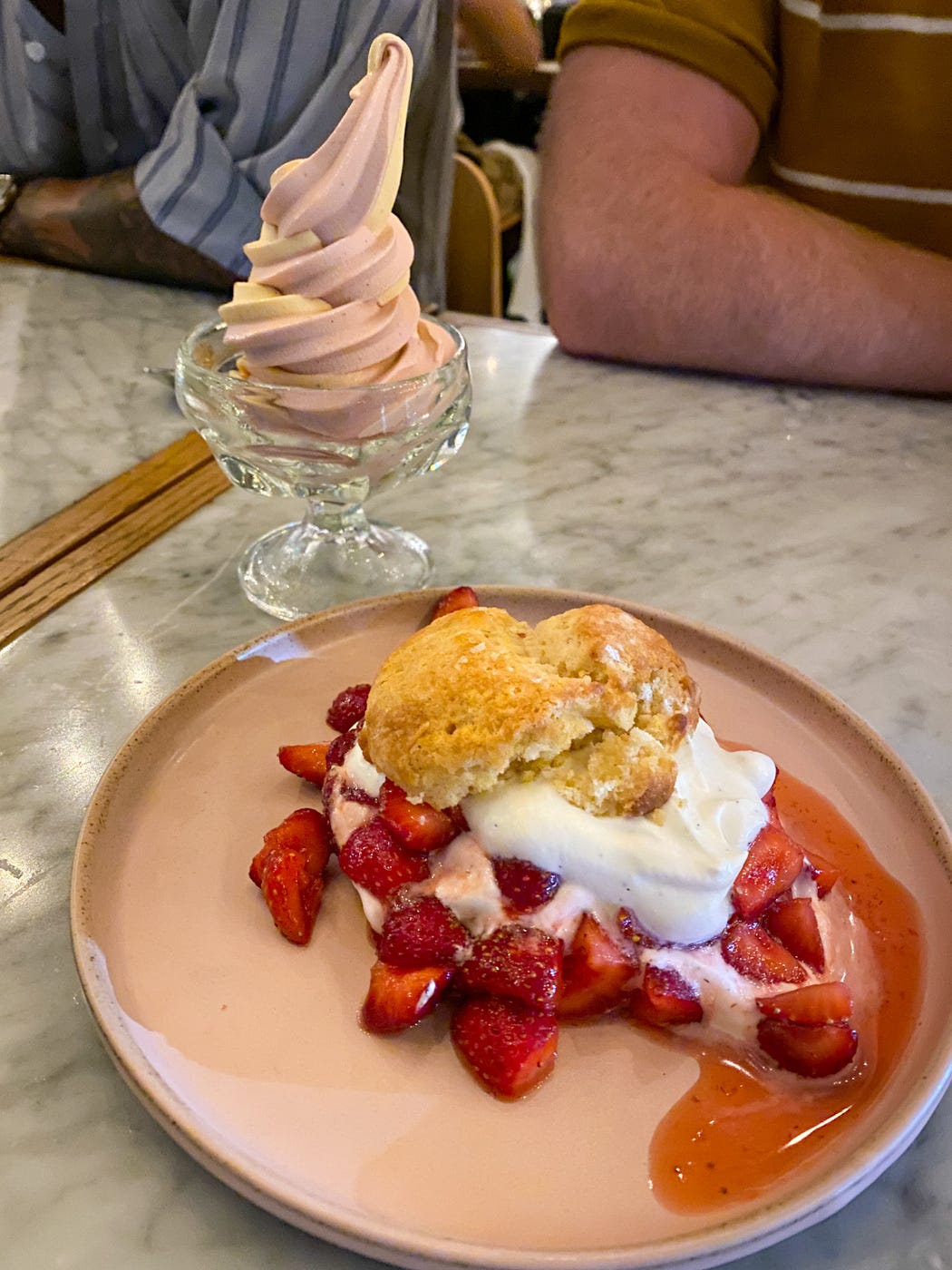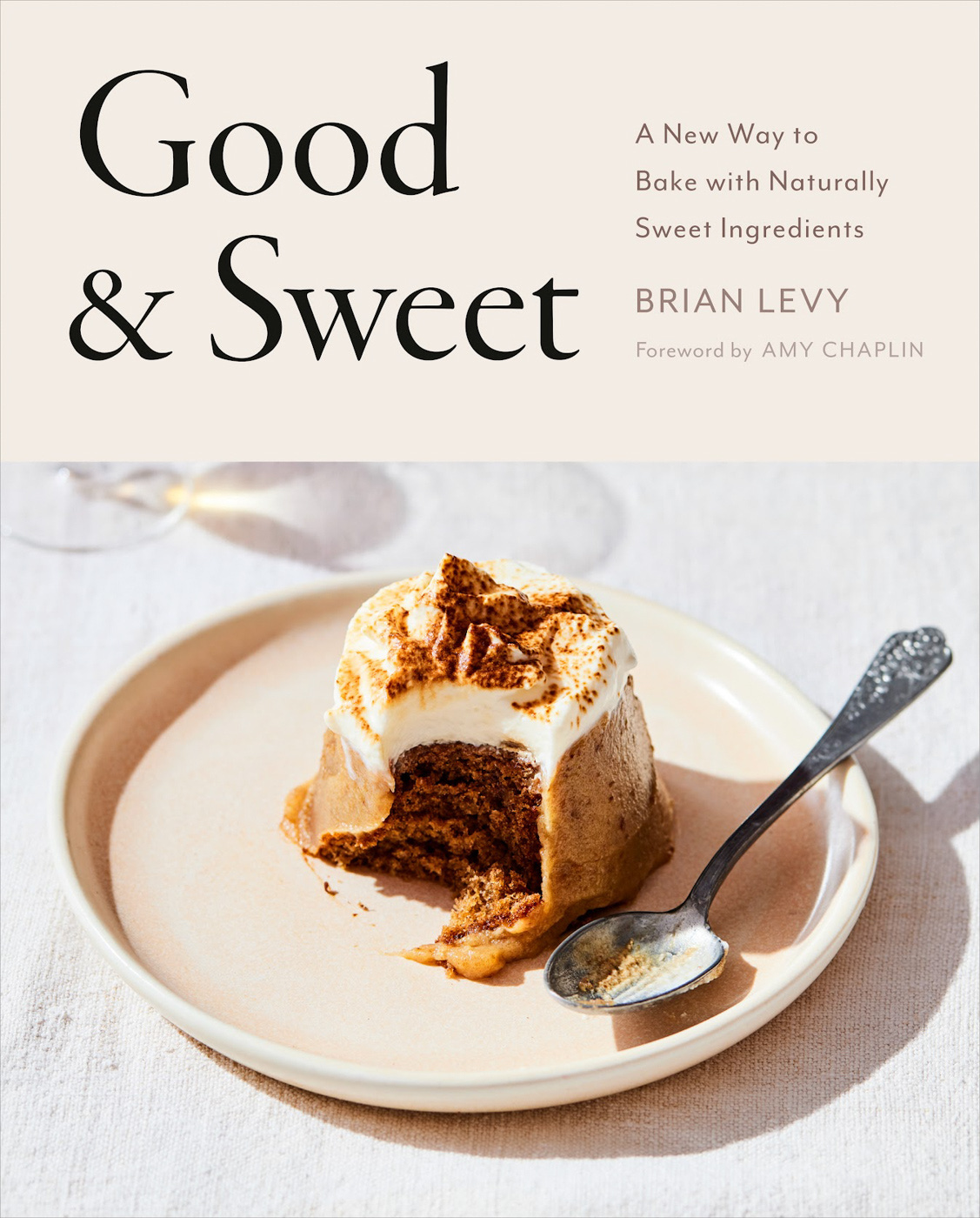The Ultimate Tomato Sandwich
Plus: Chef Jon Kung on the Pod, A Trip to Saffy's, and a Q&A with Good & Sweet author Brian Levy.
Hey everyone,
Yesterday there was some drama at the Atwater Village Farmer’s Market. I explained it all to Craig and this was his response.

Well it turns out there really was drama; turns out the lines were long because someone fired a gun at the Hollywood Farmer’s Market. How awful! No one was hurt, thank goodness. But maybe now Craig really will adapt it into a movie.
But you’re not here for farmer’s market news, you’re here for the tomatoes. Here’s what I did with them when I got home:
It’s funny, since I’ve become a TikTok superstar (jk, but my Stanley Tucci pasta video has 1.2 million views!), I’ve been thinking more creatively in the kitchen.
Normally if I was making a tomato sandwich I’d just slather on mayo, slice a tomato, sprinkle with salt and pepper, and call it a day. But I’ve always thought grinding the basil in a mortar and pestle with garlic and then stirring in mayo would make for a most flavorful basil “aioli" that would make the tomatoes sing even more and I have to tell you, it totally worked. This was one of the best tomato sandwiches of my life.
Speaking of TikTok superstars…
…my guest this week on the podcast is Chef Jon Kung, who has 1.6 million followers on TikTok and is beloved for the way that he infuses thoughtful commentary about identity with his gorgeous cooking. In today’s conversation, we talk about his beginnings as a chef in Detroit, how the TikTok thing started, how shirtlessness plays into things, and where he sees himself going over the next decade.
Listen wherever you listen to podcasts or listen right here:
Last night, I joined my friends J and Ben for dinner at Saffy’s, the new casual dining spot from the owners of Bestia and Bavel here in L.A.
If you’ve ever been to Bestia or Bavel, you know that they’re some of the best restaurants in L.A. You also know that they’re extremely stressful, high-intensity environments with swarms of people and the volume set at eleven. That’s what made Saffy’s so great: it had casual outdoor seating and a relaxed, breezy atmosphere with the same stupendous food.
This dish was probably my favorite of the night and it was so deceptively simple: “endive and grilled onion salad.” Look at how they shaped the grilled onion to match the shape of the purple endive. And then the dressing was potent and lemony with hints of za’atar.
The tomato salad came on top of a smoked eggplant purée with feta, cinnamon (!), sesame & nigella, savory, and cilantro.
It was delicious, even though it made my mouth tingle in a weird way (Ben said it was because of the eggplant + the acid of the tomatoes). But it was worth it.
The kebabs were gorgeous and served with a variety of sauces (tzatziki, chili oil) and lavash that made it a whole interactive experience.
And the dessert was not to be missed: peach and raspberry soft serve swirl and a most lovely strawberry shortcake.
Four stars to Saffy’s. I just wish it was easier to get a reservation (I had to play the Resy lottery for a while to score mine).
Now, for a new occasional feature in The Amateur Gourmet newsletter: a Q&A!
Today we have Brian Levy, the author of the brand new cookbook, Good & Sweet, a bold new dessert book that offers delectable sweet recipes that don’t have sugar!
Don’t worry, it’s not a health food book. There’s still butter and cream cheese and all the other good stuff, just no processed sugar. Here’s Brian to explain it all.
What inspired you to write this book and how difficult was it to pull off?
My first inspiration came when I was eating a really sweet fruit (a mango) and thought Can’t I make a dessert out of this without adding more sugar? I successfully made a mango custard with only the sugars naturally occurring in the fruit, and that led me to try other experiments. Eventually, I looked for existing recipes that used only the sweetness of fruits, grains, nuts, etc. to make desserts, but I turned up empty-handed. I kept the experimenting going over the course of several years and realized that these recipes would make a great book—and a book unlike any other out there.
It was difficult! Cane and other added sugars perform a lot of roles in conventional recipes, so to make desserts without them was a huge challenge. There were lots of flops. But every time there was a success, I felt like I’d cracked the code a little more and knew how to apply what I’d learned to my next experiment.
We both knew the late great pastry chef Gina DePalma (Dolce Italiano), can you share some of the things that you learned from her?
Gina first let me work without pay on nights and weekends in the pastry kitchen at Babbo, and after some months she hired me as a pastry cook. I learned so much from her. In addition to all of the technique and the fun of recipe development, she taught me a lot about productivity and efficiency; there’s always something to be done, there’s always something you can work on now that will make your day tomorrow easier and better. I also learned from her to take good care of kitchen equipment; I still use the stand mixer she gave me in 2005! Gina was a supportive friend both when I worked for her and long after; she always encouraged my new pursuits and helped me believe in myself. A few recipes in the book are inspired by hers, like the Sesame Semifreddo with Chocolate Cookie Crust and the Olive Oil Zucchini Spice Cake.
In the early days of text messaging, Gina also taught me to always double-check that I was sending a message to the intended recipient. But that’s a story for another time!
A lot of the recipes in the book use dates as a sweetener. I love dates; how did you figure out that you could use dates so successfully instead of sugar? Were there any hiccups?
There is a lot of dried fruit in general in these recipes. I didn’t use any single “sweetener” as a sugar replacement. Instead, I approached each recipe as a new project and asked myself what sweet ingredients were appropriate for the flavors and textures of the given recipe. Dates happen to be one of the most neutral-tasting of the dried fruits, as well as the sweetest and least acidic, so they’re the easiest to fit into a lot of recipes. But I tried not to rely on them too much (in my mind, I almost thought of dates as cheating) and sought them out only when it made good sense with a recipe.
That said, dates are incredible! I can’t wait to visit LA in September and taste newly harvested dates at the farmers market (I’d also love to visit a date farm). We obviously don’t have a chance to do that here in the Northeast.
How did I figure out that I could use dates? Well, I did tons of research on what whole foods naturally contain a significant amount of sugar. That included fresh fruits, dried fruits, nuts, grains, miso paste, vegetables, dairy products, and much more. I made a database for myself with all of this information and referred to it constantly in the early stage of development for each recipe. Dates, with a sugar content of about 67%, were high on the list.
I also notice milk powder is prevalent in a lot of these recipes. What does milk powder offer that regular milk doesn't?
So, a big part of the challenge with developing these recipes was how to add sweetness without adding a bunch of water. Fresh fruit, for instance, contains a lot of water, and even dried fruit contains a decent amount. For every recipe, I needed to consider how much liquid I was adding relative to a conventional recipe and make up for it by omitting liquid somewhere else. So milk powder allowed me to add milk to a recipe without adding liquid. It also has its own uniquely malty-vanilla sweet flavor and is a good sweet, flavorful ingredient in that regard. It also works as a garnish—sprinkled over the Chocolate Buckwheat Cookies, for instance—in cases where you might traditionally use powdered sugar.
Finally, which recipe are you most enthusiastic for people to try first? And which one do you make the most often for yourself or company?
Tough question, but I’d say I’m most excited for people to try the Black & White Milkshake. I have always loved milkshakes, and this one uses just a few ingredients (no ice cream!) quickly blitzed together in a blender, and it is so delicious. It embodies what I really wanted to prove with Good & Sweet: that it’s possible to make sweet treats that don’t taste like they’re from the health-food store—without any added sugar. I think it will really surprise people that this milkshake’s sweetness comes entirely from coconut milk, a few dates, some milk powder and cashews.
Aside from the milkshake, I’ve probably made the Spiced Pumpkin Pie, the Saffron & Lemon Rice Pudding, and the Sticky Toffee Pudding the most.
Thanks so much, Brian! Can’t wait to cook from your book.
Now for some links to tickle your fancy:
I’m excited for the new season of Top Chef which is filming in… London! (Deadline);
Is it actually sexy to date a chef? (Grub Street);
A Guide to Boba (Eater LA).
That’s all for this week folks!
Just for fun, I created an Amazon shop so I could share all of my favorite cookbooks, food memoirs, kitchen gadgets, ingredients, etc. Check it out if you like that kind of thing.
And if you missed last Thursday’s paid subscribers only newsletter, you missed Ottolenghi’s fig cake, mustard brown sugar salmon, and more details about Stanley Tucci’s zucchini pasta.
Don’t miss the next one! Become a paid subscriber here:
Until next time….
Your friend,
Adam
















I made The Ultimate Summer Tomatoes sandwich few days ago, it was so good that I forgot to take pic of it..
Next time I'll send you a pic.
Thank you very much for the recipe.
That tomato sandwich looks delish, and really enjoyed the Q and A - Good and Sweet sounds like such a labour of curiosity and love. Off to order it from the library!